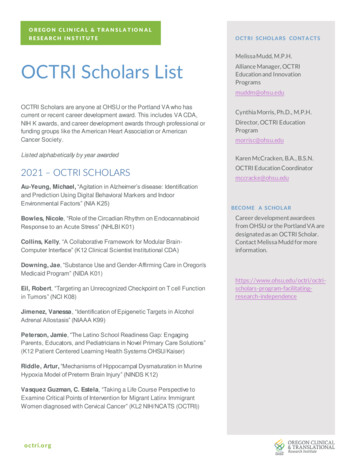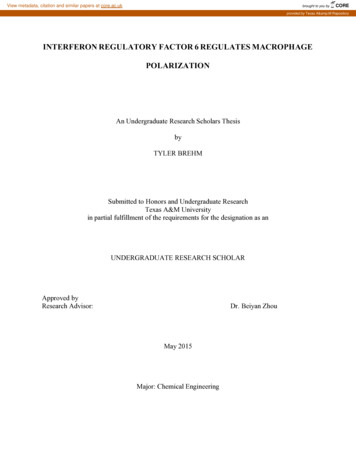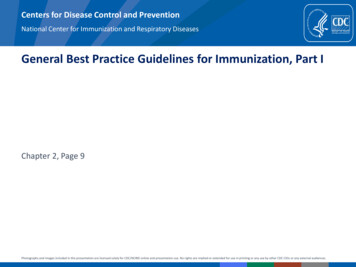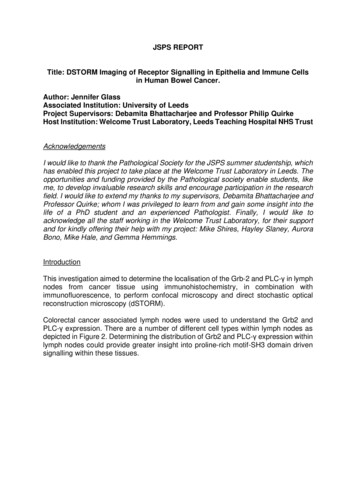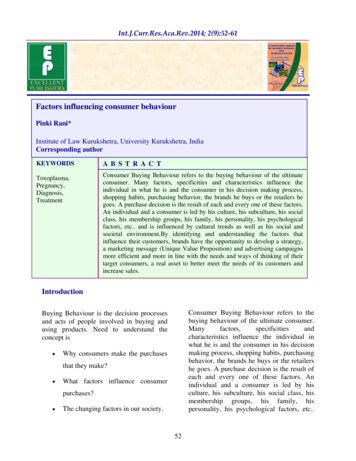
Transcription
ISSN (Print): 2476-8316ISSN (Online): 2635-3490Dutse Journal of Pure and Applied Sciences (DUJOPAS), Vol. 7 No. 1 March 2021Seroprevalence of Toxoplasma Gondii AntibodiesAmongst Neonates in Ahmadu Bello UniversityTeaching Hospital (ABUTH), Shika, Zaria, NigeriaAdamu A. S.11,2, *Ya’aba Y.1, Mohammed S.B.1,Yakubu G. J.1, Aminu M2.Department of Microbiology and Biotechnology,National Institute for Pharmaceutical Researchand Development (NIPRD)Abuja, Nigeria2Department of Microbiology,Faculty of Life Sciences,Ahmadu Bello University, Zaria.Email: yakyabnig@yahoo.comAbstractToxoplasma gondii is an obligate intracellular protozoan parasite, which causes toxoplasmosis with aglobal distribution amongst humans and animals. Congenital toxoplasmosis generally occurs when awoman is newly infected with T. gondii during pregnancy and transfer the parasite unknowingly tothe foetus. This study was carried out to determine the seroprevalence of T. gondii among neonates inAhmadu Bello University Teaching Hospital (ABUTH), Zaria. Prior to sample collection, wellstructured pre-tested questionnaires were used to obtain socio-demographic data and possible riskfactors of the neonates through their biological mothers. A total of 92 blood samples were collected forthe screening of T. gondii antibodies from neonates in this study. Due to the ages of the neonates andthe condition they were born into, some of the blood samples (n 4) collected were not up to thequantity required for screening of both antibodies. As such, only IgM were screened for such samplesleaving out IgG (i.e. IgM, n 92; and IgG, n 88). It was found that 23.9% (21/88) and 2.2% (2/92)neonates were positive for IgG and IgM antibodies respectively. Higher prevalence of T. gondii IgGwas found among females (30.4%: 14/46) (χ2 0.627, df 4, P 2.597) compared to males(16.7%:7/42). T. gondii IgG antibodies were detected with the highest prevalence among neonates of16-20 days (33.3%:7/21) while the lowest was recorded in neonates of 6-10days (14.3%:2/14). It wasconcluded that toxoplasmosis among neonates in ABUTH is not common and detection for IgG andIgM antibodies before or during pregnancy is recommended.Keywords: Toxoplasma gondii, Antibodies, Neonates, Congenital, ELISA, IgG, and IgMIntroductionToxoplasma gondii is the causative agent of toxoplasmosis (Oyeyemi et al., 2019). T. gondii is aparasitic protozoan with an obligate intracellular mode of living (Gyang et al., 2015). It canreproduce asexually in varying tissues of their intermediate hosts being mostly vertebrates.However, T. gondii reproduce sexually in epithelial tissues of the digestive tracts of cats*Author for CorrespondenceYa’aba Y. , DUJOPAS 7 (1): 54-64, 202154
Seroprevalence of Toxoplasma Gondii Antibodies Amongst Neonates in Ahmadu Bello University TeachingHospital (ABUTH), Shika, Zaria, Nigeriabeing the definitive hosts. Cats get infected with T. gondii when they ingest meatscontaminated by the cyst but rarely infected through direct ingestion of oocystsdisseminated by feces of other infected cats (Nasir et al., 2015; Sharif et al., 2018). T. gondii is azoonotic pathogen of warm-blooded animals including birds and man (Bello et al., 2017). T.gondii is however, transmitted horizontally to humans through consumption of water, fruits,vegetables, food and undercooked meat that has been contaminated with oocysts of T. gondii(Farouk et al., 2020; Fanigliulo et al., 2020). T. gondii has an incubation period of 5-18 daysfollowing infection of a susceptible host (Nasir et al., 2015), it can however remain inactiveand persist all through the life time of the infected persons (Ohiolei and Isaac, 2016).Over 70% of the world population is infected with T. gondii. Although the prevalence of thisparasite varies from one country to another (Fanigliulo et al., 2020), however, T. gondii hasbeen reported to be present in every country of the world (Karshima and Karshima, 2020).Immunocompetent individuals infected with T. gondii are often asymptomatic and showlittle or no clinical symptoms. Some of the symptoms caused by toxoplasmosis inimmunocompetent individuals include fatigue, listlessness, excessive sweating, headache,joints and muscle pains, retinochoroiditis, fever and maculopapular rash (Ohiolei and Isaac,2016; Karshima and Karshima, 2020). Due to occurrence of similar symptoms oftoxoplasmosis with mononucleosis or dromes makes acute toxoplasmosis to be undiagnosedas such, it is mostly not reported (Ohiolei and Isaac, 2016). However, individuals who showcervical lymphadenopathy with other forgoing symptoms are often suspected to besuffering from toxoplasmosis. Clinical manifestation of toxoplasmosis is common amongindividuals below 15 years alongside other immunocompromised persons (Ohiolei andIsaac, 2016).Although T. gondii affects all age group across the world, it is more deleterious to pregnantwomen and their neonates (Oyeyemi et al., 2019). Pregnant women who are infected with T.gondii can be haematogenously transferred from the mother to the placenta and infects thefoetus in a process known as vertical transmission to cause what is known as congenitaltoxoplasmosis (Oyeyemi et al., 2019). The extent of health defects caused by congenitaltoxoplasmosis depends on the gestation stage of the pregnancy and the length of exposure(Fanigliulo et al., 2020). However, the general risks caused by untreated congenitaltoxoplasmosis ranges from 20-50% (Fanigliulo et al., 2020). Some of the health defects causedby congenital toxoplasmosis include hydrocephaly or microcephaly, cerebral calcifications,miscarriage, still birth, or abortion (Ohiolei and Isaac, 2016; Fanigliulo et al., 2020; Karshimaand Karshima, 2020). Children that survive may experience developmental problems,including attention deficit, mental retardation, ocular dysfunction (chorioretinitis),lymphadenopathy, hepatosplenomegaly, seizures, epilepsy and even schizophrenia(Oyinloye et al., 2014; Ohiolei and Isaac, 2016; Adeniyi et al., 2018; Orevaoghene and Wogu,2020).In order to prevent health impacts caused by congenital toxoplasmosis, early detection ofIgM and IgG antibodies of T. gondii is paramount among both infected and non-infectedpregnant women as well as providing vital information on how to prevent contracting theparasite as well as serological follow up of those who have tested positive to the parasite(Nasir et al., 2015). Developed nations such as Germany, France and Austria have been ableto reduce the occurrence of congenital toxoplasmosis through compulsory testing ofpregnant women going for antenatal (Adeniyi et al., 2018). However, low awareness indeveloping countries and cost of tests, reagents and equipment has deterred early detectionof T. gondii among pregnant women thereby increasing its prevalence. Karshima andYa’aba Y. , DUJOPAS 7 (1): 54-64, 202155
Seroprevalence of Toxoplasma Gondii Antibodies Amongst Neonates in Ahmadu Bello University TeachingHospital (ABUTH), Shika, Zaria, NigeriaKarshima (2020) reported continental prevalence range of T. gondii to be 6.8–51.8% inEurope, 10.6–13.0% in North America, 14.0–96.3% in Asia, 26.3–80.0% in South America, and4.3–75.0% in Africa (Karshima and Karshima, 2020). These values however, vary betweenindividual nations due to different hygiene practices, dietary habits and socioeconomicstatus of its citizens (Fanigliulo et al., 2020).In Nigeria, the seroprevalence of T. gondii also varies across states. Oyinloye et al. (2014)reported a prevalence of 40.8% in Lagos, 44.4% in Calabar, 21.6% in Sokoto, and 22.2% inMaiduguri. Adeniyi et al. (2018) reported a prevalence of 30.44% in Osogbo; Farouk et al.(2020) reported a prevalence of 20.5% in Gombe. Low awareness and knowledge of T. gondiiis lacking in Nigeria as studies carried out by Adeniyi et al. (2018) reported that 90.4% ofwomen assessed were not aware of the existence of T. gondii neither were they aware of thehealth impact caused by it. As such this study was aimed at determining the seroprevalenceof T. gondii among pregnant women attending antenatal in Ahmadu Bello UniversityTeaching Hospital (ABUTH) Zaria, Nigeria.Materials and MethodsStudy AreaThe study was hospital based and was conducted at Ahmadu Bello University TeachingHospital (ABUTH), Shika, Zaria, Nigeria. Zaria, Nigeria is located at latitude 11.085541, andthe longitude is 7.719945 with coordinates 11o 5’ 7. 9476” N and 7o 45’ 11. 8020” Erespectively. The hospital is positioned in Shika, a small settlement about 2km away fromSamaru, Sabon Gari Local Government Area Kaduna, State.Study PopulationThe target population was some neonates (babies at the first 28days of birth), in the specialbaby care unit of the ABUTH Zaria.Inclusion CriteriaBabies of 28 days old and below.Exclusion CriteriaBabies more than 28 days old.Sample Size DeterminationThe sample size was determined using the formula by Agabi et al (2010);Z confidence level (0.95); P prevalence 87% 0.87; D sample error (0.05);q 1-p 1-0.87 0.13Therefore 40The calculated sample size was 40 hence; the least number of samples that could be used forthe study was 40.Ya’aba Y. , DUJOPAS 7 (1): 54-64, 202156
Seroprevalence of Toxoplasma Gondii Antibodies Amongst Neonates in Ahmadu Bello University TeachingHospital (ABUTH), Shika, Zaria, NigeriaEthical ApprovalPermission and approval for the study was obtained from the medical board of the AhmaduBello University Teaching Hospital (ABUTH) Zaria with an introductory letter signed by theHead of Department, Microbiology Department, Ahmadu Bello University Zaria.The aim of the study was clearly explained to the mothers of the neonates and informedconsent was obtained before administering questionnaires. To ensure confidentiality, namesof the respondents were not recorded on the questionnaire. The questionnaire wasinterpreted in local languages for those who do not understand English.Research Tool AdministrationPrior to sample collection, demographic data such as sex, contact with cats, contact with soil,drinking of unpasteurized milk, from the mothers of the neonates using a structuralquestionnaire were obtained.Sample Collection and ProcessingA total of 92 blood samples were collected for the screening of T. gondii antibodies fromneonates in this study. Due to the ages of the neonates and the condition they were borneinto, some of the blood samples (n 4) collected were not up to the quantity required forscreening of both antibodies. As such, only IgM were screened for such samples leaving outIgG (i.e. IgM, n 92; and IgG, n 88). Prior to sample collection, socio-demographic datasuch as sex, age of baby, ownership of cat, eating raw or undercooked meat, contact withsoil, drinking of unpasteurized milk, eating of unwashed fruits and vegetables were allcaptured. About 2 mL of the blood samples were collected in a sterile plain bottle andtransported back to the Department of Microbiology Ahmadu Bello University, Zaria in anice bag. The samples were allowed to thaw then centrifuged at 1500 rpm for about 15 min.Using a sterile Pasteur pipette, the sera was separated and labelled accordingly beforestoring it in a freezer at -20 C till further use.Sample AnalysisThe samples were analysed using the commercial immunoassay kit Diagnostic AutomationIn-cooperation for Toxoplasma IgG and IgM analysis of all immunoassay procedures wereperformed according to the manufacturers’ instructions.Assay ProcedureThe blood samples and all the reagents were brought to room temperature (18-32 C); thestock wash buffer was diluted 1 bottle to 100 mL of distilled water. The micro wells werenumbered, including 2 for negative control, 1 for positive control, and 1 for blank. A 1:40dilutions was prepared by adding 5 µL to the test samples, negative control, positive control,and calibrators to 200 µL of sample diluent and was mixed well. A 100 µL of diluent sera,calibrators, and controls were dispensed into the appropriate wells. For the blank reagent,100 µL sample diluent was dispensed in 1A well position. The holder was tapped to removeair bubbles from the liquid and mixed well. It was then incubated for 30 min at roomtemperature. Liquid was removed from all the wells and washed three times using thewashing buffer. A 100 µL of enzyme conjugate was dispensed to each well and incubated for30 mins at room temperature. The enzyme conjugate was removed from all the wells andwashing was repeated three times with washing buffer. A 100 µL of chromogenic substratewas dispensed to each well and incubated for 15 mins at room temperature then 100 µL ofthe stop solution was added. The result was read immediately at 450 nm with a microwellreader.Ya’aba Y. , DUJOPAS 7 (1): 54-64, 202157
Seroprevalence of Toxoplasma Gondii Antibodies Amongst Neonates in Ahmadu Bello University TeachingHospital (ABUTH), Shika, Zaria, NigeriaResultsSeroprevalence of IgG and IgM antibodies to T. gondii among neonates in ABUTH, ZariaThe results of this study revealed the presence of T. gondii IgG antibodies in 21 new-borns(23.9%) and IgM in 2 new-borns (2.2%) as shown in Table 1.Table 1: Seroprevalence of T. gondii antibodies among neonatesAntibody typeTotal Sample ScreenedNo. positivePercentage (%)IgGIgM889221223.92.2Seroprevalence of T. gondii in relation to age group and sex of neonatesThe sero prevalence of T. gondii according to age (Table 2) showed highest prevalence of IgGantibodies (33.3%:7/21) among babies who were 16-20 days and the lowest (14.3%:2/14)among those who were 6-10 days (p 0.5533). Also, IgM antibodies were detected in onlytwo of the neonates who were in the age group 6-10 days and 11-15 days (p 0.64).Out of the 88 samples screened, 7 males (16.7%:7/42) and 14 females (31.1%: 14/46) testedpositive to T gondii IgG antibody. Whereas 2 neonates; 1 male (2.2%:1/45) and 1 female(2.2%:1/45) tested positive to T. gondii IgM antibody with P-value 0.987 as shown in Table2.Table 2: Seroprevalence of T. gondii in relation to age group and sex of neonates** IgGVariableAge group(days)0-56-1011-1516-2021-25SexMaleFemale* 1000.06.34.50.00.0* 0.64** evalence of T. gondii according to clinical manifestationOut of 17 neonates who had symptoms of fever, only 8 (47.1%) tested positive to IgGantibodies while 1 (5.6%) out of 18 neonates that had symptoms of fever tested positive toIgM antibodies. There was significant difference p 0.015 with patients tested for IgMantibodies. However, no significant difference was seen for IgM antibodies p 0.307 amongneonates who had fever as shown in Table 3.Ya’aba Y. , DUJOPAS 7 (1): 54-64, 202158
Seroprevalence of Toxoplasma Gondii Antibodies Amongst Neonates in Ahmadu Bello University TeachingHospital (ABUTH), Shika, Zaria, NigeriaTable 3: Seroprevalence of T. gondii according to clinical NANA Not AvailableNo of SamplesNo of PositiveNo of Negative1765068(47.1)12(18.5)0 (0.0)9(52.9)53(81.84)6(100)1868061(5.6)1(1.5)0 evalence of T. gondii according to knowledge, source of knowledge and clinicalmanifestationThe result was analyzed according to those with the knowledge of T. gondii, and (42.9%: 3/7)which had knowledge of the parasites had antibodies. However, of those with noknowledge, (22.2%: 18/81) also had antibodies to T. gondii. The difference in sero-Prevalenceobtained was not statistically significant (χ 2 1.510, df 1, p 0.219). Further analysisaccording to those who had knowledge in relation to the source shows that a marginaldifference (P 0.053) exists. All those who got the knowledge from the hospital hadantibodies while only one out of five who got knowledge from media had antibodies to T.gondii as shown in Table 4.Table 4: Seroprevalence of T. gondii according to knowledge, source of knowledge andclinical manifestationVariablesNo. of samples (%)No. of positive (%)No. of negative (%)YesNo7 GWhereP 0.053IgMWhereP 0.537Seroprevalence of Toxoplasma gondii in relation to various risk factors (IgG)The result was analysed according to the risk factors that might be associated with T. gondiiis shown in Table 4. In relation to ownership of cat, those that had cats had higherYa’aba Y. , DUJOPAS 7 (1): 54-64, 202159
Seroprevalence of Toxoplasma Gondii Antibodies Amongst Neonates in Ahmadu Bello University TeachingHospital (ABUTH), Shika, Zaria, Nigeriaprevalence of (22.2%:4/18) and lowest prevalence compared to those who do not own cats(24.3%: 17/70). The difference observed in the seroprevalence was not statistically significant(χ 2 0.034, df 1, p 0.855).Analysis of the result in relation to eating raw or undercooked meat showed a higherprevalence of (33.3%:2/6) compared to those that do not eat raw or undercooked meat(23.2%:19/82). The difference observed in seroprevalence was not significant (χ 2 0.318, df 1, p 0.573).In relation to contact with soil T. gondii antibodies was detected with a higher prevalence of(33.3%:4/12) compared to those that do not have contact with soil (22.4%:17/76). Thedifference observed in seroprevalence was not significant (χ2 0.686, df 1, p 0.408).In relation to Drinking unpasteurized milk, a significant prevalence of (47.1%:8/17) wasobtained among those who drank unpasteurized milk compared to those who do not drinkunpasteurised milk (18.3%:13/71) (χ 2 6.239, df 1, p 0.012).In relation to eating unwashed fruits and vegetables higher prevalence of (28.6%:2/7) wasobtained compared to those who do not eat unwashed fruits and vegetables (23.5%:19/81)for those that do not eat unwashed fruits and vegetables. The difference observed inseroprevalence was not significant (χ 2 0.093, df 1, p 0.761).Analysis of the result in relation to the presences or absence of fever in mothers of theneonates showed a significant difference in the prevalence obtained (χ 2 5.976, df 1, P 0.015). Whoever there was no significant difference (χ 2 1.046, df 1, p 0.307) between theprevalence of IgM antibodies and presence of fever. The clinical manifestations presented bythe patients presenting with fever 1(5.6%) and those without fever was 1(1.5%). Thedifference in seroprevalence obtained was however not statistically significant (χ 2 1.046, df 1, p 0.307) for IgM as shown in Table 5.Table 5: Seroprevalence of Toxoplasma gondii in relation to risk factors (IgG)VariableIgGOwn a catYesNoNo of sampleNo positive (%)No of 1)0.855Raw or undercooked ontact with Consumption ofunpasteurized Consumption of unwashedfruits and .761Ya’aba Y. , DUJOPAS 7 (1): 54-64, 202160
Seroprevalence of Toxoplasma Gondii Antibodies Amongst Neonates in Ahmadu Bello University TeachingHospital (ABUTH), Shika, Zaria, NigeriaDiscussionAntibodies are important in detection of so many infections relating to the blood and itscomponent; they are often produced in response to the presence of antigens or anyinfectious agents in the body. Like every other infectious agent, T. gondii causes an immuneresponse by the body through the production of antibodies (IgG and IgM) responsible tofight this parasite (Bello et al., 2017). As such, the T. gondii IgG and IgM specific antibodiesare used for the diagnosis of toxoplasmosis (Bello et al., 2017). Result of the present studyshowed seropositivity of T. gondii to be 23.86% (21/88) for IgG and 2.17% (2/92) for IgMantibodies respectively. The seroprevalence of specific antibodies recorded in this study(23.86% for IgG and 2.17% for IgM) agree with the result obtained by Orevaoghene andWogu (2020), which recorded seroprevalence of T. gondii specific antibody IgG to be 32%while IgM was 2%. An overall seroprevalence of 25% (IgG and IgM) antibody was recordedin this study and was quite similar to the 22.2% obtained by Oyinloye et al. (2014) and lowerthan 31.3% obtained by Bello et al. (2017). These dissimilarities could be as result ofdifference in the hygiene practices relating to the mothers of test subjects, sensitivity of testkits, types of subjects (i.e. pregnant and non-pregnant women, neonates, children 15 years,and adults) as well as varying geographical dispensation.The seroprevalence of T. gondii specific antibodies in relation to age was found to be highest(33.3%) among children aged 16-20 days. Though study of Uttah et al. (2013), Gyang et al.(2015) and Fanigliulo et al. (2020) reported an age-related increase in the seroprevalence of T.gondii specific antibody. However, this study saw a scattered pattern of prevalence rateamong varying age group, which is in concordance with the result reported by Oyinloye etal. (2014), Imam et al. (2016), and Adeniyi et al. (2018) where there was no consistent patternof seroprevalence increase in association with the ages of test subjects.There is a high development of innate immunity and other immune responses in females.However, humans regardless of their sexes are prone to infections provided that allnecessary health precautions are not followed as well as other underlining health disorder(Kennedy et al., 2014; Ruggieri et al., 2016). The overall seroprevalence of T. gondii specificantibodies in relation to sexes is most prevalent (31.91%) in females than males (17.8%) inthis study. This could be as a result of high immune response to antigens exhibited generallyby females making them highly detectable (Ruggieri et al., 2016). However, this resultdiffers from the one obtained by Orevaoghene and Wogu (2020), which reported highseroprevalence rate among males (42.12%) compared to females (36.89%). Reasons could beas a result of infectious rate of the parasite or the hygiene practices observed by the mothersof these neonates. Most studies on toxoplasmosis including Oyinloye et al. (2014), Imam et al.(2016), Bello et al. (2017), Adeniyi et al. (2018) among many others have been focussed onpregnant women and females within the child bearing age because of the adverse effects itcauses to their pregnancy and children that survive the gestation period. As such, there ispaucity of data on the seroprevalence of T. gondii specific antibodies in relation to sexes ofneonates in Nigeria.Clinical manifestations are often used in diagnosis of several health disorders; some mayshow signs and symptoms early others do not show until the diseases reach a later stagecausing severe damage to host cells if adequate measure is not implemented. Like otherdiseases, toxoplasmosis causes fever, though most of its symptoms are often confused for fluor cold due to their similarities as it has been seen in this study where 47.1% of neonateswho had fever tested positive for IgG while 5.6% tested positive for IgM. This is in line withYa’aba Y. , DUJOPAS 7 (1): 54-64, 202161
Seroprevalence of Toxoplasma Gondii Antibodies Amongst Neonates in Ahmadu Bello University TeachingHospital (ABUTH), Shika, Zaria, Nigeriathe reports of Ohiolei and Isaac (2016), which stated that toxoplasmosis has similarsymptoms with flu and cold.Toxoplasmosis is a neglected disease in Nigeria since adequate awareness is not raisedamong its citizens predisposing individuals to this parasite (Ohiolei and Isaac, 2016;Oyeyemi et al., 2019). The inadequate knowledge of T. gondii was confirmed in this study asrecord 92.05% of the participants tested for IgG and 91.3% were ignorant of T. gondiiinfections and the effects its effects on their babies. The few participants (7.95% for IgG and8.7% for IgM) reported to have knowledge about toxoplasmosis came through mediapublicity. This implies that, health workers in hospitals and clinics have little or noknowledge of toxoplasmosis, as such did not communicate the necessary information totheir clients. Participants who consume unpasteurized milk, unwashed vegetables, andundercooked meat had high prevalence of T. gondii antibodies compared to those who donot practice any of the aforementioned predisposing factors. Although cats are the definitivehost of T. gondii, the result obtained in this study shows that by just owning a cat does notautomatically makes you a victim of the parasite but the kind of hygiene practiced, food oneeats and the processes involved in the food preparation.ConclusionToxoplasma gondii is present among neonates born in Ahmadu Bello University TeachingHospital, Shika, Zaria, Nigeria and can only arise as a result of congenital transmission fromthe mothers of theses neonates.Recommendations(i). Serological test for detecting T. gondii specific antibodies should be made compulsory toall pregnant women going for antenatal in hospitals to promote early detection of theparasites and adopting adequate precautionary measures to eradicate or limit their effects.(ii). Government and non-governmental organization should help provide equipments andreagents that are needed in hospitals for performing test used in detecting T. gondii specificantibodies.(iii). Serological test that can determine precisely how long T. gondii parasite has beenpresent in one body should be developed to help assess the extent of damage and potentialhealth defects that could arise.(iv). Food and meats should be properly cooked before consumption especially pregnantwomen.(v). Healthcare providers should educate pregnant women at their first prenatal visit aboutfood hygiene and prevention of exposure to cat feces. Health education for women of childbearing age should include information about meat-related and soil-borne toxoplasmosisprevention.ReferencesAdeniyi, O.T., Adekola, S.S and Oladipo, O.M. (2018). Seroepidemiology of Toxoplasmosisamong pregnant women in Osogbo, South-Western, Nigeria. Journal of InfectiousDiseases and Immunity, 10(2): 8-16.Agabi, A.Y., Banwat, B.E., Mawak, J.D., Lar, P.M., Dashe, N., Dashen, M.M., Adoga, M.P.,Agabi, F, Y and Zakari, H. (2010). Seroprevalence of herpes simplex virus type-2among patients attending the Sexually Transmitted Infections Clinic in Jos, Nigeria.The Journal of Infection in Developing Countries, 4(9):572-575.Ya’aba Y. , DUJOPAS 7 (1): 54-64, 202162
Seroprevalence of Toxoplasma Gondii Antibodies Amongst Neonates in Ahmadu Bello University TeachingHospital (ABUTH), Shika, Zaria, NigeriaBello, H.S., Umar, Y.A., Abdulsalami, M.S and Amusan, V.O. (2017). Seroprevalence andRisk Factors of Toxoplasmosis among Pregnant Women Attending Antenatal Clinicin Kaduna Metropolis and Environs. International Journal of Tropical Disease andHealth, 23(3): 1-11.Fanigliulo, D., Marchi, S., Montomoli, E and Trombetta, C.M. (2020). Toxoplasma gondii inwomen of childbearing age and during pregnancy: seroprevalence study in Centraland Southern Italy from 2013 to 2017. Parasite, 27: 2. Available from:https://doi.org/10.1051/parasite/2019080 (Accessed 24th Sept. 2020).Farouk, H.U., Manga, M.M., Yahaya, U.R., Laima, C.H., Lawan, A.I., Ballah, F.M and ElNafaty, A.U. (2020). Prevalence and Determinants of Toxoplasma Seropositivityamong women who had Spontaneous Abortion in Gombe, North-Eastern Nigeria.Journal of Advances in Medicine and Medical Research, 32(10): 1-10.Gyang, V.P., Akinwale, O.P., Lee, Y.L., Chuang, T.W., Orok, A., Ajibaye, O., Liao, C.W.,Cheng, P.C., Chou, C.M., Huang, Y.C., Fan, K.H and Fan, C.K. (2015). Toxoplasmagondii infection: seroprevalence and associated risk factors among primaryschoolchildren in Lagos City, Southern Nigeria. Revista da Sociedade Brasileira deMedicina Tropical, 48(1): 56-63.Imam, N.F.A., Azzam-Esra’a, A.A and Attia, A.A. (2016). Seroprevalence of Toxoplasmagondii among pregnant women in Almadinah Almunawwarah KSA. Journal of TaibahUniversity Medical Sciences, 11(3): 255-259.Karshima, S.N and Karshima, M.N. (2020). Human Toxoplasma gondii infection in Nigeria: asystematic review and meta-analysis of data published between 1960 and 2019. BMCPublic Health, 20: 877. Available from: d 24th Sept. 2020).Nasir, I.A., Aderinsayo, A.H., Mele, H.U and Aliyu, M.M. (2015). Prevalence and associatedrisk factors of Toxoplasma gondii antibodies among pregnant women attendingMaiduguri Teaching Hospital, Nigeria. Journal of Medical Sciences, 15(3): 147-154.Ohiolei, J.A and Isaac, C. (2016). Toxoplasmosis in Nigeria: the story so far (1950–2016): areview. Folia Parasitological, 63:30. Available from: https://doi: 10.14411/fp.2016.030(Accessed 24th Sept. 2020).Orevaoghene, O.E and Wogu, M.N. (2020). Comparative Seroprevalence and Risk Factors ofToxoplasmosis among four Subgroups in Port Harcourt, Nigeria. MicrobiologyResearch Journal International, 30(7): 110-118.Oyeyemi, O.T., Oyeyemi, I.T., Adesina, I.A., Tiamiyu, A.M., Oluwafemi, Y.D., Nwuba, R. I.,and Grenfell, R.F.Q. (2019). Toxoplasmosis in pregnancy: a neglected bane but lefrom:https://doi.org/10.1017/S0031182019001525 (Accessed 24th Sept. 2020).Oyinloye, S.O., Igila-Atsibee, M., Ajayi, B., and Lawan, M.A. (2014). Serological Screeningfor Ante-Natal Toxoplasmosis in Maiduguri Municipal Council, Borno State, Nigeria.African Journal of Clinical and Experimental Microbiology, 15(2): 91-96.Sharif, A.A., Aliyu, M., Yusuf, M.A., Getso, M., Yahaya, H., Bala, J.A., Yusuf, I., and Wana,M.N. (2018). Risk Factors and Mode of Transmission of Toxoplasmosis in Nigeria: AReview. Bayero Journal of Pure and Applied Sciences, 4(2): 107–121.Uttah, E.C., Ogbeche, R.A.J., Etim, H.E.L. (2013). Comparative Seroprevalence and RiskFactors of
Ahmadu Bello University Teaching Hospital (ABUTH), Zaria. Prior to sample collection, well-structured pre-tested questionnaires were used to obtain socio-demographic data and possible risk factors of the neonates through their biological mothers. A total of 92 blood samples were collected for
